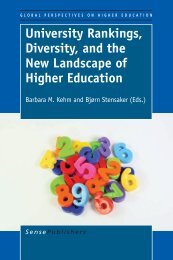Rupturing Concepts of Disability and Inclusion
Rupturing Concepts of Disability and Inclusion
Rupturing Concepts of Disability and Inclusion
You also want an ePaper? Increase the reach of your titles
YUMPU automatically turns print PDFs into web optimized ePapers that Google loves.
CHAPTER 2<br />
her claim that churches respond slowly <strong>and</strong> ineptly to people with disability<br />
because <strong>of</strong> their theological legacy. 57<br />
16<br />
Disease<br />
Lameness<br />
Madness<br />
Maimed/Crippled/Disa<br />
bled<br />
Muteness<br />
Paralysis<br />
72<br />
27<br />
14<br />
9<br />
11<br />
6<br />
The priest shall examine the disease on the skin <strong>of</strong><br />
his body, <strong>and</strong> if the hair in the diseased area has<br />
turned white <strong>and</strong> the disease appears to be deeper<br />
than the skin <strong>of</strong> his body, it is a leprous disease;<br />
after the priest has examined him he shall pronounce<br />
him ceremonially unclean. (Leviticus 13: 3)<br />
But when you give a banquet, invite the poor, the<br />
crippled, the lame, <strong>and</strong> the blind. (Luke 14: 13).<br />
So he changed his behaviour before them; he<br />
pretended to be mad when in their presence. He<br />
scratched marks on the doors <strong>of</strong> the gate, <strong>and</strong> let his<br />
spittle run down his beard. (1 Samuel 21: 14)<br />
The legs <strong>of</strong> a disabled person hang limp; so does a<br />
proverb in the mouth <strong>of</strong> a fool. (Proverbs 26: 7)<br />
... so that the crowd was amazed when they saw the<br />
mute speaking, the maimed whole, the lame<br />
walking, <strong>and</strong> the blind seeing. And they praised the<br />
God <strong>of</strong> Israel. (Matthew 15: 31)<br />
When Jesus saw their faith, he said to the paralytic,<br />
“Son, your sins are forgiven.” (Mark 2: 5)<br />
Biblical texts have also underpinned various Christian responses based around<br />
notions <strong>of</strong> sin or sanctity; curse or compassion; ridicule, rejection or romanticisation;<br />
salvation <strong>and</strong> servanthood; covenants <strong>and</strong> contracts, justice <strong>and</strong> joy. Religious<br />
institutions have <strong>of</strong>ten been seen to <strong>of</strong>fer meaning <strong>and</strong> comfort to those who find<br />
their world troubling <strong>and</strong> confusing. 53 However, paradoxically, churches through<br />
romanticised notions <strong>of</strong> suffering <strong>and</strong> healing have structurally - through belief or<br />
architecture - forced people with disability at least to the margins, some even<br />
excluded beyond to the outside. 54 Therefore, a fuller exploration <strong>of</strong> various<br />
interpretations <strong>and</strong> practices made by the Christian church to ‘disability’ in the<br />
Common Era (CE) seems pertinent.<br />
Biblical scholar, Carol Fontaine, surveys both Testaments <strong>of</strong> the Bible<br />
synchronically to view how the societies producing the text understood disability.<br />
She notes that although views <strong>of</strong> illness <strong>and</strong> disability changed over time,<br />
especially during times <strong>of</strong> contact with foreign cultures, some <strong>of</strong> which had<br />
concepts <strong>of</strong> medicine in the late period, there is an underlying unity in the way the<br />
Bible views people so ‘afflicted’. 55 Fontaine comments that while synchronic<br />
studies are <strong>of</strong> limited usefulness in such pursuits as historical reconstruction or the<br />
establishing <strong>of</strong> doctrinal ‘truth’, they providea useful entry point for discussion “by<br />
presenting a ‘gestalt’ <strong>of</strong> folk ideas, literary tropes <strong>and</strong> cultural values around a<br />
given topic.” 56 Therefore, it is useful to provide a summarised version <strong>of</strong> her texts<br />
to exemplify how she outlines the five views for consideration in order to highlight<br />
1 Illness <strong>and</strong> <strong>Disability</strong> as Undesirable Conditions – In medically naive societies,<br />
particularly ones based on agricultural production, those unable to fully<br />
participate in the common tasks <strong>of</strong> survival are seen to exist in a more<br />
precarious, <strong>and</strong> less desirable state. Where medical care is uncertain, the ill or














